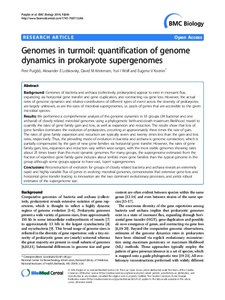| dc.contributor.author | Koonin EV | |
| dc.contributor.author | Puigbo P | |
| dc.contributor.author | Kristensen DM | |
| dc.contributor.author | Lobkovsky AE | |
| dc.contributor.author | Wolf YI | |
| dc.date.accessioned | 2022-10-28T14:19:45Z | |
| dc.date.available | 2022-10-28T14:19:45Z | |
| dc.identifier.uri | https://www.utupub.fi/handle/10024/170720 | |
| dc.description.abstract | Background: Genomes of bacteria and archaea (collectively, prokaryotes) appear to exist in incessant flux, expanding via horizontal gene transfer and gene duplication, and contracting via gene loss. However, the actual rates of genome dynamics and relative contributions of different types of event across the diversity of prokaryotes are largely unknown, as are the sizes of microbial supergenomes, i.e. pools of genes that are accessible to the given microbial species.Results: We performed a comprehensive analysis of the genome dynamics in 35 groups (34 bacterial and one archaeal) of closely related microbial genomes using a phylogenetic birth-and-death maximum likelihood model to quantify the rates of gene family gain and loss, as well as expansion and reduction. The results show that loss of gene families dominates the evolution of prokaryotes, occurring at approximately three times the rate of gain. The rates of gene family expansion and reduction are typically seven and twenty times less than the gain and loss rates, respectively. Thus, the prevailing mode of evolution in bacteria and archaea is genome contraction, which is partially compensated by the gain of new gene families via horizontal gene transfer. However, the rates of gene family gain, loss, expansion and reduction vary within wide ranges, with the most stable genomes showing rates about 25 times lower than the most dynamic genomes. For many groups, the supergenome estimated from the fraction of repetitive gene family gains includes about tenfold more gene families than the typical genome in the group although some groups appear to have vast, 'open' supergenomes.Conclusions: Reconstruction of evolution for groups of closely related bacteria and archaea reveals an extremely rapid and highly variable flux of genes in evolving microbial genomes, demonstrates that extensive gene loss and horizontal gene transfer leading to innovation are the two dominant evolutionary processes, and yields robust estimates of the supergenome size. | |
| dc.language.iso | en | |
| dc.publisher | BIOMED CENTRAL LTD | |
| dc.title | Genomes in turmoil: quantification of genome dynamics in prokaryote supergenomes | |
| dc.identifier.urn | URN:NBN:fi-fe2021042715718 | |
| dc.relation.volume | 12 | |
| dc.contributor.organization | fi=fysiologia ja genetiikka|en=Physiology and Genetics| | |
| dc.contributor.organization-code | 2606404 | |
| dc.converis.publication-id | 17363100 | |
| dc.converis.url | https://research.utu.fi/converis/portal/Publication/17363100 | |
| dc.identifier.jour-issn | 1741-7007 | |
| dc.okm.affiliatedauthor | Puigbo, Pedro | |
| dc.okm.discipline | 3111 Biomedicine | en_GB |
| dc.okm.discipline | 3111 Biolääketieteet | fi_FI |
| dc.okm.internationalcopublication | international co-publication | |
| dc.okm.internationality | International publication | |
| dc.okm.type | Journal article | |
| dc.relation.articlenumber | ARTN 66 | |
| dc.relation.doi | 10.1186/s12915-014-0066-4 | |
| dc.relation.ispartofjournal | BMC Biology | |
| dc.year.issued | 2014 | |
